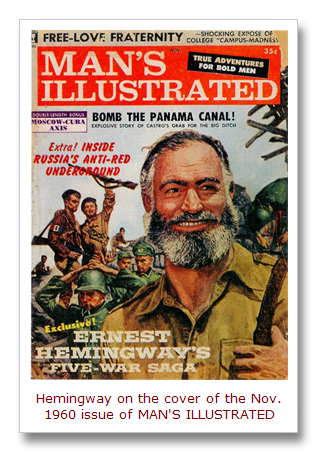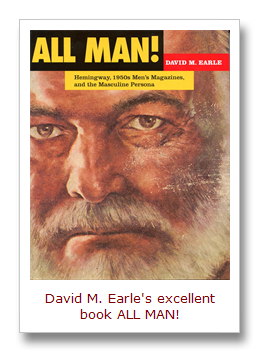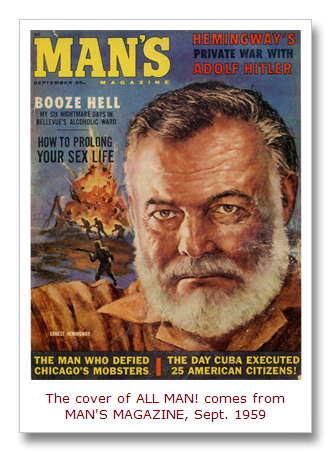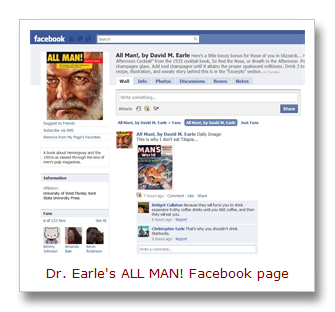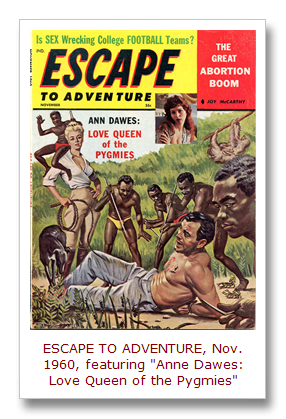The legendary American writer Ernest Hemingway loomed large in men’s adventure and bachelor magazines of the 1950s and 1960s.
In the minds of many men of that era — and perhaps in his own mind — ‘Papa’ Hemingway was the epitome of a manly man. Almost a superman. Except, of course, he wasn’t bulletproof.
On this day exactly 49 years ago, July 2, 1961, Hemingway committed suicide with one of his favorite shotguns at age 61.
So, I am designating today “Hemingway R.I.P. Day” here on the Men’s Adventure Magazines blog.
If you’re a regular reader, you probably know I am a big fan of the book that focuses on Hemingway’s image as reflected in vintage men’s adventure and bachelor magazines — ALL MAN! Hemingway, 1950s Men’s Magazines, and the Masculine Persona.
It was written by David M. Earle, an Assistant Professor of English at University of West Florida in Pensacola. Earle is one of the foremost experts on 20th Century modernist literature, vintage magazines and Hemingway.
I’ve written about Earle, his book All Man!, and his research on Hemingway and vintage men’s magazines in past entries on this blog.
In honor of Hemingway R.I.P. Day and for those of you who missed those previous posts, below are some excerpts and links to the complete entries.
You may or may not like Hemingway’s books and stories, his penchant for killing big animals and big fish, the generally dismal way he treated his wives, lovers and kids, or his boozy, bullying personality. But he was undeniably a literary giant and an intriguing cultural icon during the heyday of the men’s adventure magazines.
So, tonight I’m drinking a toast to him. Here’s to you, Ernest! Requiescat in pace.
An interview with David M. Earle, author of the new book All Man! Hemingway…
All Man!, by Dr. David M. Earle, is a fascinating new book that provides a unique perspective on men’s adventure magazines.
It traces the evolution of Ernest Hemingway’s giant-size public persona as reflected in vintage magazines, especially the men’s adventure and bachelor mags of the 1950s.
In doing this, Earle also provides fresh insights about the roles that men’s adventure and bachelor magazines played in the lives of World War II veterans and other men, especially in the Fifties.
Recently, I had the opportunity to talk with Earle and ask him some questions about All Man!
Here’s the first part of that interview…
As your book discusses, a lot of the Hemingway myth was reflected in the men’s magazines.
EARLE: Yes. And, Hemingway’s public image itself parallels the conflict between the romantic myth of the 1950s as “the Golden Years” and reality of those years. The men’s magazines of the era offer an excellent window into exploring this conflict, both of the culture and of the man.
So, that’s how you started studying men’s adventure magazines?
EARLE: I had actually done research on prewar pulp magazines and vintage men’s magazines for my previous book Re-Covering Modernism, which was more of an academic work. After that, I wanted to write a book for a wider audience that explored postwar men’s magazines. And All Man! was the fun and logical result. I initially started collecting men’s bachelor magazines, since they often published highbrow modernist authors, like Hemingway, William Faulkner and James Joyce, and I teach courses about modernist literature. But, as I collected, I came across more and more well known authors, particularly Hemingway, in the men’s adventure magazines. Indeed, there were so many examples by and about Hemingway that I saw there must have been something deeper going on in the culture and with Hemingway as a figure of masculinity.
What’s one of the most interesting things you learned about men’s adventure magazines in writing All Man!?
EARLE: The most concentrated exploration of men’s adventure magazines that I make in the book, and which I find pretty enthralling and novel still, is how they offered veterans of World War II a means to deal with and categorize both their wartime experience and the difficulties of returning to United States. They returned to a society that was, for a large part, unaware of exactly how horrible their experiences had been. The bloody realities of the war had generally been censored by the government and avoided by the press.
(Read the rest of the interview…)
Talking with Dr. David M. Earle about men’s magazines…
In between activities in his busy schedule, David was kind enough to answer some more questions I asked him about his book All Man! and vintage men’s magazines.
I started by asking him about a Hugh Hefner quote he cites in All Man!
In 1953, when Hef launched Playboy, he said it was a magazine for “urbane fellows who were less concerned with hunting, fishing, and climbing mountains than good food, drink, proper dress, and the pleasures of female company.”
Hefner’s quote is a pretty good description of one general difference between the vintage bachelor magazines and the men’s adventure and outdoor sport magazines, isn’t it?
EARLE: Yes. Playboy and the hundreds of bachelor magazines that followed in its wake were all about the fantasy of upwardly mobile bachelorhood, emulating the life of leisure. In contrast, the men’s adventure mags were decidedly blue collar.
Whereas the bachelor mags had articles and ads about leisure wear for a summer cruise, the men’s adventure magazines had ads for correspondence schools and offered stories and articles that confirmed masculinity in a different way — not by constructing a fantasy bachelor’s world, but by showing man in perilous and extreme situations, triumphant. And, again, the locals of these were as far away from the pressures of suburbia and the day-to-day job pressures as possible.
So, I guess if I had to really draw a reason behind the distinction between the bachelor and men’s adventure genres, I’d say it is economically based, though of course neither readership was mutually exclusive.
What do you think men’s adventure magazines tell us about the changes taking place in gender roles during the 1950s and 1960s?
EARLE: Wow. Huge question. Really, what we see in the men’s adventure mags is the other side of the pressures on women to conform to a social role reflected in the domestic magazines of the day, like Good Housekeeping, etcetera. In both cases, these magazines offered very extreme, very conservative roles for men and women. The most obvious reason for this, at least in the case of the women’s magazines, was a pressure to get women back in the kitchens after their empowering work in factories during World War Two. But it was also the economic and suburban boom that put pressure on having a family in the years after the war.
Of course the men’s magazines are very, very extreme in their portrayal of gender roles. Whereas women’s magazines advertised the love of an “all pink” kitchen and men as the master in the house, men’s magazines fought a fear that American suburban culture was too feminine, and was feminizing the men. And while these magazines are incredibly fun, they also often have a really troubling misogyny in them. Jem, a bachelor magazine called “the magazine for masterful men,” is perhaps the worse, but some of the adventure mags aren’t too far behind. That’s why there are so many stories in them about dangerous women: the dominatrix female Nazi guards and Amazon women — like the “Love Queen of the Pygmies” story you recently featured on your blog. At the same time, it’s why there are also many stories of women in peril who are helpless or just sex objects, hence having a man save them in the story confirms masculinity.
(Read the rest of the interview…)
* * * * * * * * * * * * * * * * *
Comments? Questions? Corrections? Post them on the Men’s Adventure Magazines Facebook Group.


